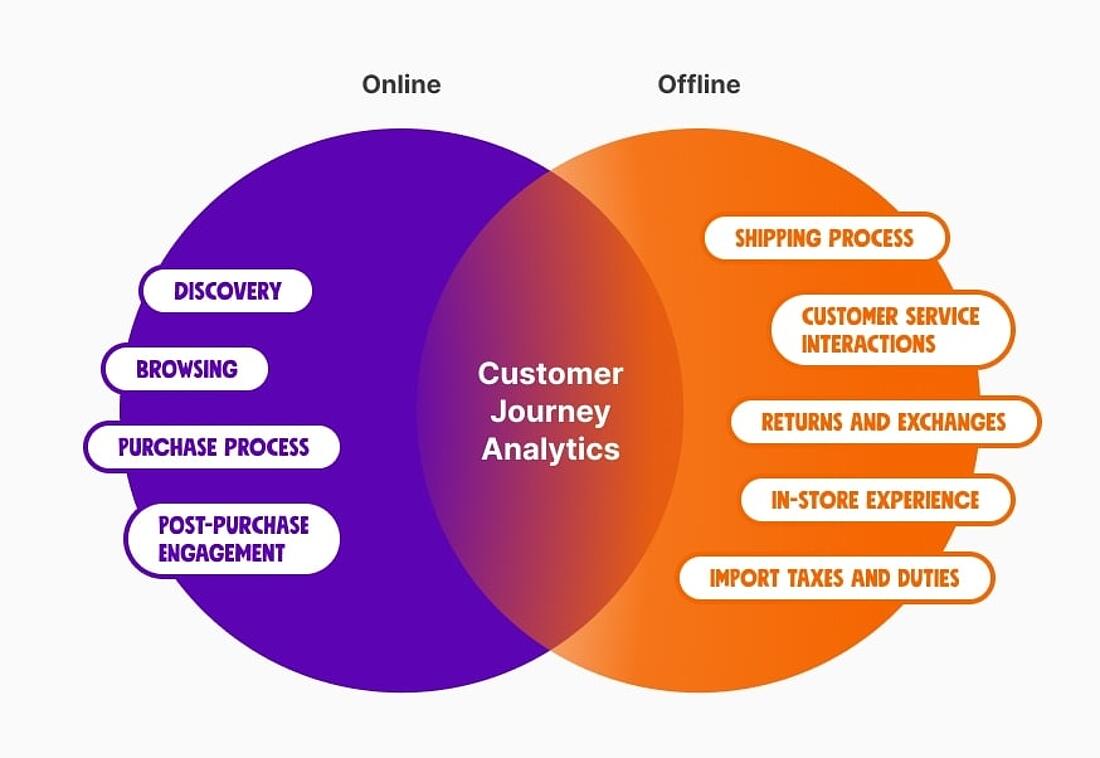- Why Us?
- Features
White Label
For SaaS Platforms & Agencies
Provide our complete analytics suite to your clients, directly within your own interface and with your/their own branding. Discover Analytics-as-a-Service and White Label Analytics. Great benefit, minimal effort.
- Pricing
- White Label
- Success Stories
- ResourcesGetting Started
CONTENTS
- What is Customer Journey Analytics?
- Case Study: the eCommerce Returns Process
- Customer Journey Analytics Vs. Customer Journey Mapping
- Steps Of Customer Journey Analytics
- Real Examples Of Customer Journey Analytics
- Customer Journey Mapping Platforms
- TWIPLA
- Lucidchart
- Social Sprout
- FAQ For Customer Journey Analytics
- What Is Customer Journey Analytics
- What Is The Benefit Of Customer Journey Analytics?
A Practical Guide to Customer Journey Analytics

Did you know that 89% of successful businesses say that anticipating what customers need at every stage of their journey is critical to growth?
That’s just one of the many statistics from Google’s “An Audience of Individuals” report that underline the importance of customer journey analytics.
In this blog, you’ll learn exactly what CJA is, with real-world customer journey analytics examples. It includes a roadmap for improving customer satisfaction across touchpoints, and also lists three of the best customer journey mapping platforms on the market today.
What is Customer Journey Analytics?
→ The "Customer Detective Kit" 🔍

Customer journey analytics (CJA) is the practice of examining how customers engage with a business across all touchpoints.
Otherwise known as customer journey data analytics, it includes both online and offline milestones.
This distinguishes it from digital experience analytics, which is limited to interactions in the online world.
Additionally, customer journey analytics takes a holistic view of the entire customer journey across various channels - a key distinction from user journey analytics, which focuses specifically on user behavior within digital platforms.
If you want, try thinking of CJA as a "customer detective kit" - a Sherlock URL-mes who investigates the full scope of a customer’s journey and finds subtle clues that lead to better decisions and targeted improvements.
Some notable customer journey analytics use cases include:
→ identifying key drop-off points in the purchasing process,
→ optimizing the onboarding experience for new users,
→ improving customer support interactions,
→ and tailoring marketing campaigns based on user behavior and preferences.
For an ecommerce business, the online CJA touchpoints would cover:
- Discovery: How internet users discover the webstore, such as through Google Search, social media, or paid ads.
- Browsing: The ways customers navigate the website, including product searches, filtering options, and content engagement.
- Purchase Process: The entire checkout experience, encompassing cart additions, payment methods, and confirmation notifications.
- Post-Purchase Engagement: Follow-up emails, customer feedback requests, and personalized recommendations for future purchases.
However, eCommerce has one foot in the physical world.
As such, customer journey analytics would also include the following offline touchpoints:
- Shipping Process: The experience of receiving the product, including shipping notifications, delivery tracking, and the condition of the package upon arrival.
- Customer Service Interactions: Any offline interactions customers have with support teams, whether through phone calls or in-store visits for returns and inquiries.
- In-Store Experience: For businesses with physical locations, this includes how customers interact with products, staff, and the overall atmosphere in-store.
- Returns and Exchanges: The process customers go through to return or exchange products, which can greatly impact their overall satisfaction and likelihood of future purchases.
- Import Taxes and Duties: The clarity and transparency regarding any import taxes or duties that customers may incur upon receiving their products, which can affect their overall purchasing experience and satisfaction.
Clearly, there are many milestones in the customer journey that all need to be refined for a smoother experience.
By tracking each interaction, marketers can uncover patterns in customer behavior and gain a deeper understanding of their experiences.
This insight helps to optimize business outcomes by refining marketing, customer service, and product strategies.
Case Study: the eCommerce Returns Process
→ Using CJA to increase customer satisfaction

Let’s look at a real customer journey analytics example from the world of retail.
Imagine an eCommerce business that is suffering from a low NET Promoter Score and an unacceptable number of returns despite selling a popular range of Nike trainers.
This is overwhelming their customer support team and driving up costs.
Here’s how customer journey analytics would play out:
The Customer Journey
First off, the business worked to map the the return journey, which typically looks like this:
- The customer initiates a refund from their Returns webpage.
- They print a return label and drop the package at a Evri pickup point.
- The company receives the package, processes it, and issues a refund.
The Pain Points
By tracking eCommerce KPIs and using customer journey analytics, the business identified issues affecting satisfaction:
- Some customers struggle to find the return instructions, leading to confusion.
- This often results in calls to customer service, making the process frustrating.
- Regular shipping delays mean customers wait longer than expected for refunds.
The Conclusion
The business realized that unclear return instructions and delayed refunds were causing frustration, leading to a low NPS score and a high volume of messages to their customer support team.
The Action
To resolve this issue, the business redesigned their Returns webpage to make it easier to understand the returns process and print the shipping label.
→ Customers can now easily generate return labels, select preferred shipping options, and receive instant notifications when the return is processed.
They also tell customers that the refund process takes ten days.
→ But since the business in reality completes the refund within five days, customers receive their money faster than expected - a useful trick for increasing satisfaction.
The business also decided to move away from Evri and handle shipping in house to remove an unreliable third-party from the returns process.
The Result
After these changes, the company noticed an immediate decrease in the number of customers contacting their support team.
They even started receiving messages from customers delighted with the speed with which they received their refunds - despite the fact that nothing had actually changed.
The business also continued monitoring their NPS score, and found that it started increasing almost immediately after they implemented changes.
Customer Journey Analytics Vs. Customer Journey Mapping
Customer journey analytics (CJA) and customer journey mapping are complementary but distinct tools that help businesses understand their customers.
Customer journey mapping is a visual representation of the typical path customers take, outlining each touchpoint in a hypothetical or idealized journey.
It provides a strategic overview, helping teams see where customers might encounter obstacles or become frustrated.
Customer journey analytics, on the other hand, dives into real-time data on actual customer behaviors, giving businesses the power to monitor and analyze interactions as they happen.
Where journey mapping shows potential pathways, CJA captures real customer movements and patterns, allowing businesses to identify emerging trends, detect issues, and optimize experiences based on actual insights.
Together, journey mapping sets the foundation, and CJA refines it through data-driven insights.
Steps Of Customer Journey Analytics
While every business may prioritize different customer journey milestones, each one plays a crucial role in creating the seamless experience that customers now expect.
Below, you’ll find five key steps to customer journey analytics that will help you optimize interactions with your business:
- Define Key Touchpoints
Identify the major interactions customers have with your business, such as browsing, purchasing, or returning products. - Collect Data
Gather data from each touchpoint across channels - website, customer service, and emails - to build a comprehensive view of the customer journey. - Map the Customer Journey
Visualize the journey to see how customers progress from one stage to the next, including any detours or delays. - Analyze Pain Points
Use data to identify where customers encounter obstacles or frustrations, impacting satisfaction and completion rates. - Optimize and Implement Changes
Based on insights, adjust the journey to improve the experience, such as simplifying processes, adding resources, or streamlining transitions between touchpoints.
Of course, customer journey analytics is an ongoing process, so you’ll want to continually monitor results and track performance metrics to evaluate the impact of changes and refine the journey further.
Real Examples Of Customer Journey Analytics
→ Listing the Tools Your Business Needs

Customer journey analytics can be facilitated with tools that include customer journey mapping, behavior analytics, and feedback acquisition.
Here are seven customer journey analytics examples that cover all the different stages involved:
- Conversion Funnels
Analyzing conversion funnels helps businesses pinpoint where customers drop off in their online journey, allowing for targeted optimizations to improve conversion rates and overall sales performance. - Session Recordings
Session recording tools capture real-time user interactions on a website, enabling businesses to observe common user pathways and identify potential issues or friction points in the customer journey. - Heatmaps
Heatmap features visualize where users click, scroll, and spend time on a website. Understanding user behavior in this way helps businesses adjust their layouts and content to better meet customer needs. - Customer Feedback Platforms
Survey tools and others feedback platforms gather direct input from customers about their experiences, providing valuable insights into satisfaction levels and areas for improvement across the business. - Social Listening Tools
These tools monitor social media platforms for customer sentiment and feedback. By analyzing conversations about the brand, businesses can better understand public perception and adjust their strategies accordingly. - Outgoing Traffic Analytics
This feature provides insights into where customers go after leaving a website, allowing businesses to understand customer behavior beyond their own digital properties. - Customer Relationship Management (CRM) Systems
CRM systems are crucial for tracking customer interactions across various channels, managing relationships, and analyzing data to enhance customer experiences throughout the journey.
By utilizing these customer journey analytics tools, companies can gain a comprehensive understanding of their customer journeys, leading to more informed decisions and enhanced user experiences.
Customer Journey Mapping Platforms
Effective customer journey mapping is essential for visualizing customer interactions and optimizing the overall experience.
Here are three notable customer journey analytics software that businesses can adopt today:
TWIPLA
Complete Website Intelligence Solution
TWIPLA is an advanced privacy-perfect web analytics platform, with a range of user behavior analytics tools that allow businesses to visualize and analze customer interactions across various touchpoints.
By integrating data from conversion funnels, session recordings, heatmaps, and outgoing traffic analytics, TWIPLA helps organizations understand the full spectrum of the customer experience - making it easier to identify pain points and opportunities for improvement.
Lucidchart
AI-Powered Diagramming App
Lucidchart is a versatile diagramming tool that supports customer journey mapping through intuitive visualizations.
Users can create detailed journey maps that illustrate each stage of the customer experience, making it easier to collaborate and communicate insights across teams. Its integration capabilities with other platforms enhance its functionality for businesses.
Sprout Social is an all-in-one social media management solution that supports customer journey mapping by capturing and analyzing social interactions across platforms.
With its ability to track engagement, sentiment, and customer feedback, Sprout Social helps businesses gain insights into the social touchpoints of their customer journey, fostering better communication and collaboration across teams.
Its integration with other platforms enhances its utility, making it a valuable tool for understanding the social aspects of the customer experience.
Smaply
Journey Mapping Software
Smaply specializes in customer journey mapping, offering tools to create visual representations of customer interactions and experiences.
It provides features for personal development, journey mapping, and stakeholder mapping, enabling businesses to gain a deeper understanding of their customers' needs and motivations, which helps drive better decision-making.
These platforms each equip businesses with the tools necessary to map and optimize customer journeys effectively, leading to enhanced satisfaction and loyalty.
FAQ For Customer Journey Analytics
What Is Customer Journey Analytics
Customer journey analytics (CJA) tracks and analyzes customer interactions across all touchpoints, online and offline. It provides real-time insights into the customer journey, helping businesses understand behavior patterns and improve customer experience.
What Is The Benefit Of Customer Journey Analytics?
CJA offers actionable insights into customer behavior, enabling businesses to enhance satisfaction, personalize experiences, identify pain points, and improve overall outcomes based on real-time data.
Share article
Get Started for Free
Gain World-Class Insights & Offer Innovative Privacy & Security

You might also like
What Is Digital Experience Analytics? A Complete A-Z Guide 23 October 2024 - by Simon Coulthard
23 October 2024 - by Simon Coulthard









Social Sprout
Social Media Management Platform